I love birds. I had dreams of birds flying to me and landing on my palm or shoulders sometimes. The best part of visiting the Buddhist scenic partk is playing with the pigeons. It is like my dreams come true. Birds are one kind of smartest animals. On a busy street in Japan, crows place nuts on the middle of the road. They wait for cars to run the nuts over, then they take the nuts. Parrots can copy human's words. Pigeons recognize the long way home. And I had seen a series of pictures of a male bird crying for a dead female bird. So birds have good brains and feelings, and human should not eat birds.
我爱鸟,有时候还会夢到鸟飛到我身边,站在我的手上。曾经养过鸟,因疏於照顾而嗚忽哀哉,自责不已,就决定不再养鸟了。到靈山最爱的就是喂食鸽子,那些鸽子会飛来我们的身边手上,人与鸟没有距離的感觉真棒,我还试着把二颗玉米放在Winston頭上,想讓鸽子飛上去站到Winston頭上,结果,有二隻鸽子飞来他的肩膀望着玉米,但一直不敢飛上他的頭,我想鸽子是聪明的动物,牠们一定曾经站在别人頭上,被拍打走,才会從此不敢冒犯人类的頭顶。鸟类是聪明的动物之一,日本的乌鸦知道要把核果放在路中间,讓车子碾过,再回来取食,鹦鹉会模仿人类说话,鸽子会認路回家也会传信,难以想像那麽小的脑袋瓜,也能哪麽聪明。和鸽子近距離接触後,我和Richy决定不食鸟类这种有靈性的动物了。
No money, no honey!
没有食物,鸟不理!
鸟食来啦!
Winston也要幫忙餵鳥
慢慢来,一次一颗哦!
拜託,忍一下,别大下去哦!
It is not easy to have more than one bird on one hand, especially when they flap.
雖然爱鸟,可是當鳥拍动翅膀时,好怕吃進病毒和细菌。
问Winston此行最好玩的是啥,答案:餵鳥
我也是!
The Chinese Style Buddha Statue and Temple
或许是宗教無形的约束,到了这里,幾次排隊被插隊都气得差点要骂人了,马上自律、收起脾气。
~阿彌陀佛~







